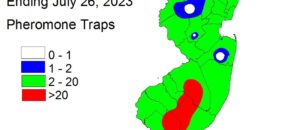Phytophthora blight, caused by Phytophthora capsici, can cause crown and fruit rot in eggplant. Unfortunately, most of New Jersey has been plagued by heavy rains and pop-up thunderstorms these past few weeks making conditions ideal for pathogens such as Phytophthora blight on pepper, eggplant, tomato, and cucurbit crops. Control of Phytophthora blight is extremely difficult […]
Continue reading...Phomopsis fruit rot in eggplant
Phomopsis blight is caused by the fungal pathogen, Phomopsis vexans. It survives between seasons in the soil on infested plant debris. Although the pathogen can infect stems and older leaves, fruit infections are most prominent. Cankers that develop on stems and branches can cause the entire plant to collapse and die. Circular, grayish spots may […]
Continue reading...Vegetable IPM Update 7/26/23

Sweet Corn Fall armyworm (FAW) is increasing in coastal areas, and has been detected at several interior sites as far north as Ocean County. Some infestations in whorl corn are in excess of 20%. It is very possible that economic infestations are present in much of southern New Jersey now. Growers are advised to check […]
Continue reading...Rutgers Tree Fruit IPM Report for July 25, 2023
Peach: Oriental Fruit Moth: A biofix point for OFM was set on 4/10 in both northern and southern counties. Third generation timings are updated below: OFM 2nd Generation Timing Insecticide Type County/Region Degree Days by 7/25 base 45 Conventional 2100-2200 2350-2450 Diamide 2025-2150 2375-2450 Gloucester – Southern 2226 1st – 7/22-24 2nd – 7/28-7/31 1st […]
Continue reading...Agri-Technology and Vegetable Research Twilight Meeting
Where: Rutgers Agricultural Research and Extension Center (RAREC), 121 Northville Rd., Bridgeton, NJ 08302 When: Wednesday August 16, 2023, 5 PM until dark, refreshments and ice cream will be served This year’s twilight meeting at RAREC will showcase new agricultural technologies for stakeholders in the state. We will showcase the newly installed agrivoltaics system established at RAREC […]
Continue reading...Recognizing Angular Leaf Spot in Cucurbits
Angular leaf spot, caused by the bacterium (Pseudomonas syringae pv. lachrymans), is common in New Jersey and the region. Although it often shows up during cooler, wet weather; it can show up almost anytime during the production season with favorable weather conditions for its development. Angular leaf […]
Continue reading...